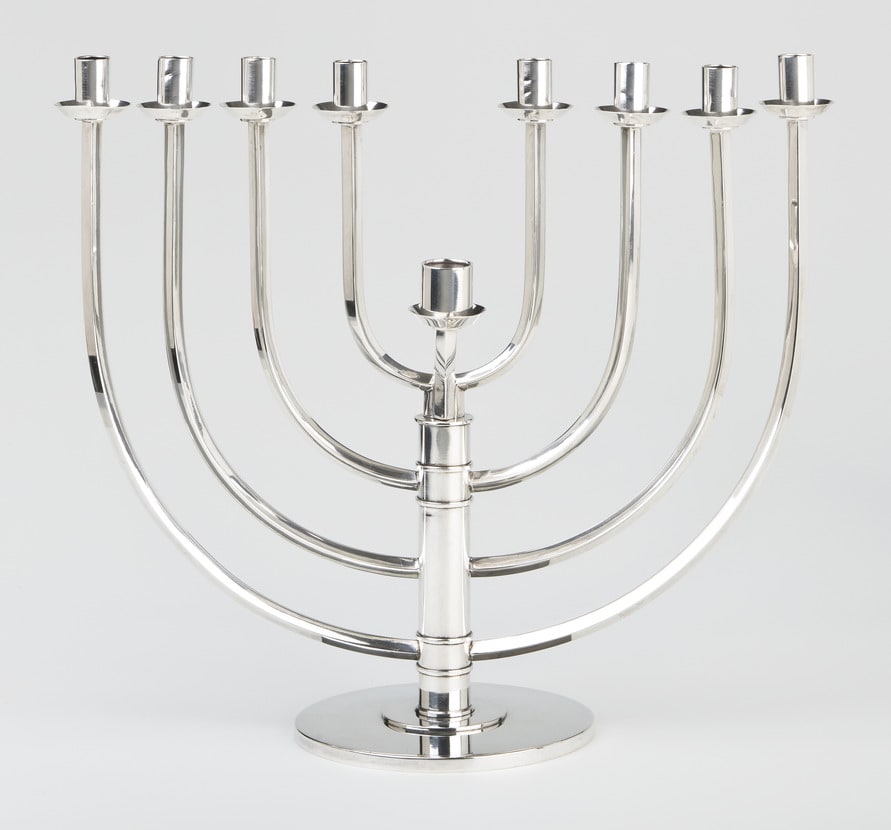
- Object Name:
- Hanukkah Lamp
- Artist/Maker:
- David Heinz Gumbel
- Bio:
- Israeli, b. Germany 1906-1992
- Place Made:
- Heilbronn, Germany
- Date:
- early 1930s
- Medium:
- Silver: hand-worked
- Dimensions:
- 11 5/8 × 13 5/16 × 5 1/4 in. (29.5 × 33.8 × 13.3 cm)
- Credit Line:
- Gift of Hannah and Walter Flegenheimer
- Accession Number:
- 2002-9a-d
- Copyright:
- MALKA COHAVI & STUDIO D.H.GUMBEL, THE SOLE OWNER OF THE COPYRIGHTS
Not On View
This Hanukkah lamp is highly unusual for the period as it brings to a Jewish ritual object the design aesthetic of the Bauhaus. The lamp's style emphasizes the sleek, elegant proportions and unadorned surfaces advocated by the Bauhaus school and popular in the most avant-garde design trends of the 1930s. In Germany, contemporary art ran afoul of the Nazis. They ordered the removal of abstract art, which they termed "degenerate," from museums throughout Germany and forced the closure of the Bauhaus -- Germany's foremost school of contemporary design, architecture, and art. It is therefore remarkable that Judaica made in this revolutionary style survived. This Hanukkah lamp was purchased directly from Gumbel in Germany and brought to America in the 1930s. Its swift exit from Hitler's Europe undoubtedly accounts for its existence today.
The lamp's creator, master silversmith David Heinz Gumbel, was born in Sinsheim, Germany, near Heidelberg. He studied at the Kunstgewerbeschule in Berlin-Charlottenberg from 1927 to 1931. Although Gumbel did not actually study at the Bauhaus, he was profoundly influenced by its teachings and incorporated its design aesthetic into his silver and Judaica. In 1934 Gumbel fled Nazi Germany and moved to Palestine. As a member of the faculty of the recently opened New Bezalel School in Jerusalem, he joined a group of highly cultured artists and colleagues who worked under the directorship of Joseph Budko, a craftsman who championed the modernist aesthetic. Gumbel taught silversmithing, hammered work, and jewelry design at Bezalel, and retired in 1955. His personal style always remained classic modern -- his objects emphasize streamlined design and graceful contours.
The lamp's creator, master silversmith David Heinz Gumbel, was born in Sinsheim, Germany, near Heidelberg. He studied at the Kunstgewerbeschule in Berlin-Charlottenberg from 1927 to 1931. Although Gumbel did not actually study at the Bauhaus, he was profoundly influenced by its teachings and incorporated its design aesthetic into his silver and Judaica. In 1934 Gumbel fled Nazi Germany and moved to Palestine. As a member of the faculty of the recently opened New Bezalel School in Jerusalem, he joined a group of highly cultured artists and colleagues who worked under the directorship of Joseph Budko, a craftsman who championed the modernist aesthetic. Gumbel taught silversmithing, hammered work, and jewelry design at Bezalel, and retired in 1955. His personal style always remained classic modern -- his objects emphasize streamlined design and graceful contours.
Information may change as a result of ongoing research.